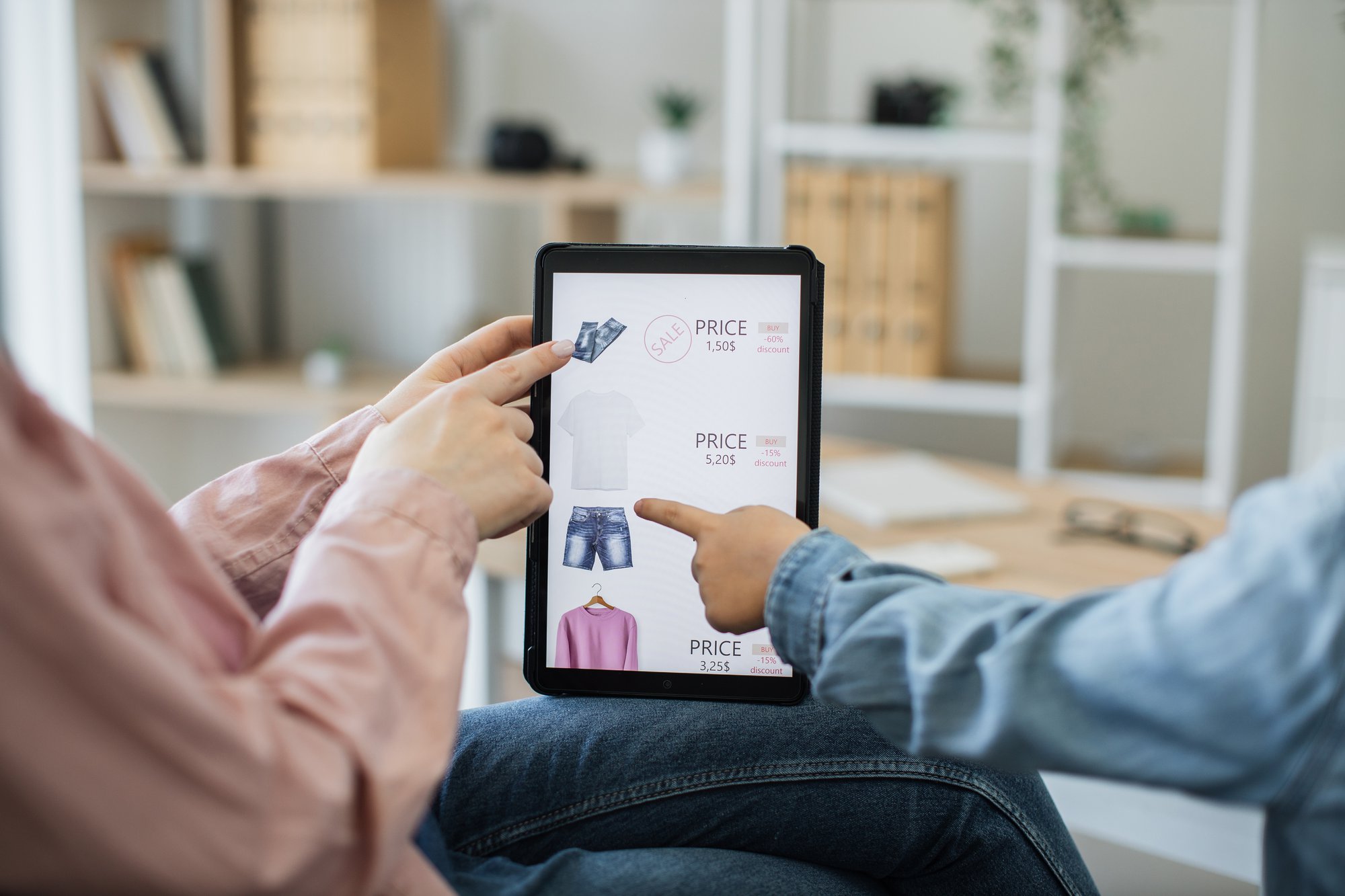eCommerce is slowly gaining momentum at the expense of physical, in-store sales. In fact, both online sales and their share of the retail market continue to increase. But brands and retailers who have yet to upgrade their virtual stores or improve their eCommerce merchandising strategies risk missing out on the online gold mine.
Experts project global eCommerce sales to reach $6.3 trillion by 2024 and a whopping $8 trillion by 2027. The share of the retail market is increasing in lockstep. Online sales will likely make up 20% of the retail market this year and 22.6% by 2027.
Of course, success isn’t as simple as setting up an online store and watching the money come flooding in. Thousands of other brands and retailers read the same marketing reports and subscribe to the same newsletters. They have the same idea and have made the same preparations. So, it’s very possible that the eCommerce merchandising or marketing strategy you apply won’t be enough to create space between you and your competitors.
You must to do more to make sure your products get the attention they deserve. At the same time, you also need to ensure the people visiting your stores will enjoy the customer experience. Above all, nothing should get in the way of customers making a purchase.
Curating Product Pages for a Unified Experience
Product catalogs are an important part of the online shopping experience. Like customers at a physical store, online shoppers need to be able to view products and their variants, such as additional colors. But one thing that separates eCommerce customers is their desire to know what other shoppers think about a certain product they’re eyeing.

Today’s top retail consumer groups are Gen Zers and millennials, both of whom trust their peers more than brands. They rely heavily on shopper reviews and are drawn to the most popular items. What’s more, they crave personalized shopping experiences.
To attract customers and keep them interested in your products, marketers and retailers must offer more than the standard catalog experience. An item’s photo, description, and price simply won’t do anymore. Rather, eCommerce merchandising practices built on content curation is the solution.
Each section of your website–including each product page–should offer a “stream of engagement.” That is, shoppers should be able to see product details and images, buyer reviews and photos, and even marketing content such as user guides, tutorials, and product specs. You should also add in content from your social posts such as likes and engagement to offer social proof for a product or trend. Then, recommend items to go with the one they’re considering.
The goal here is to use curated content from your website, social media, and users to create a unified shopping experience around each product. This can lead to more visibility and sales.
The Challenges of a Limited Catalog
Of course, regularly including original content in your product catalog can be a time-consuming and expensive approach to keeping your brands relevant. Many retailers would love to liven up each page in their online catalog. Unfortunately, their small team of merchandisers might not have enough time and resources to pull it off. They might choose a smaller product catalog instead, with few items and fewer variations. While this might look more streamlined, it’s actually less engaging.
Thankfully, various software options and automated tools can help with tedious merchandising tasks. These tools provide a richer customer experience by making it easier to implement your eCommerce merchandising strategies.
Let’s look at some solutions that can free product catalogs from their usual limitations:
Slicing and Variation Groups
Even a plain shirt can come in many different colors and patterns. A physical store can display each option separately for buyers to compare, but too many options can be overwhelming online. Instead, online retailers use eCommerce merchandising options such as slicing or variation groups.
Slicing works with just one variation at a time. Items are grouped based on a single attribute, such as color or size. For example, a product page can show a shirt in its base color. But when customers click the small colored boxes called swatches next to the item, the resulting image display changes to the selected color.

Variation groups let catalogs filter items based on several attributes. Basically, you can specify your catalog search results to display items that are of a specific size, color, and type. Say you want to see shirts with collars that are green and come in a size medium. Variation groups will only show results that fulfill all three options. For some advanced software, merchandisers can designate options such as a leading color to ensure the right variant appears in each catalog category.
Optimizing Variation Grouping
An even better way to improve catalog views is to optimize variation grouping. A store merchandiser will often encounter items in specific colors that sell less often than other colors. The normal category page will display the item in its leading color, which is usually the most popular variant.
But adding that same product in the same leading color to the “Items on Sale” category can confuse buyers into believing the popular variant is on sale. Optimizing variation grouping lets merchandisers assign different product variants as the leading image for different categories.
Storytelling Within Your eCommerce Merchandising
Marketing 101 will tell you that you’re not selling a product; you’re selling a lifestyle. It’s not about the shirt; it’s about the “look.” This is where storytelling comes in. By featuring your product in an ideal lifestyle setting, it’s easier to convince shoppers to buy it.
Using storytelling in your eCommerce merchandising can transport customers to who or where they want to be. It can also communicate your brand values in unique ways that will resonate with shoppers. Here are some examples of how you can infuse elements of storytelling within your pages.
Motivating Style Hacks Within Your Catalog
Style hacks are a great way to combine products from various categories and show the results to your lifestyle audience. For instance, retailers can promote an outdoor lifestyle featuring products culled from clothing, outerwear, and camping collections. With lifestyle photography, they can then produce collages and mix-and-match layouts that inspire customers to develop custom sets.
If your catalog’s preview feature allows users to select products and make combinations, then your store can offer the resulting mashup as product bundles. Note, however, that lifestyle hacks only work for their intended audience. Selling lifestyle products usually means promoting them to those who have already embraced the lifestyle.
At the same time, companies selling a particular lifestyle should have values and beliefs that reflect the chosen lifestyle. Otherwise, both authenticity and credibility will take a hit.
Ethical Business Decision Making
Reminding your customers of the values you share with them can go a long way in winning their trust. In fact, brands that target millennial and Gen Z consumers can get a credibility boost by mentioning their ethical practices.

For instance, the product catalog is a great opportunity to highlight products that use sustainable raw materials. You can also use storytelling to show your support for fair trade and raise awareness of slave labor and slave wages in manufacturing. Or highlight the fact that your company fully complies with environmental and sustainable manufacturing practices that minimize its carbon footprint.
Communicating Social Responsibility Within Your Brand
Your catalog can also showcase certain products and specify how buying them supports local industries and advocacy groups. But don’t let the product story begin with sourcing local materials and end with its purchase by a socially conscious consumer.
Complete the circle by including instructions on how to safely dispose of the used product. You might encourage buyers to recycle the item, donate it, or return it to be resold at a discounted price. This will impart a welcome challenge to buyers to keep the social responsibility cycle alive after they use the product.
Guided Shopping in eCommerce Merchandising
A satisfactory customer experience should be at the top of every online retailer’s list of objectives. A single derailment in the purchase cycle can be enough for a customer to abandon the shopping cart entirely. Slow-loading pages, compulsory registrations, and repetitive requests for payment information are among the common issues that turn customers away.
A guided shopping approach in eCommerce merchandising can take shoppers from browsing to buying. First, companies should abandon their reliance on demographic data from cookies and instead listen to individual customers. For example, data from previous purchases enables brands to tailor recommendations that appeal to repeat customers. A shopper who leaves a positive review for both product and customer service is more likely to buy again.
Guided shopping can also anticipate when the customer will need to reorder a product. A well-timed, personalized email or text reminding them to restock can be a great nudge. Sweeten the deal with free or expedited shipping or a special offer to help with the decision-making process.
In the absence of a previous purchase history, companies can track a user’s navigation history throughout the online store. You can see which items the shopper looked at but didn’t buy. Then, send a special offer to encourage the customer to come back and make the purchase.
Sharing Branded News and Innovations
The presence or absence of information is a big factor that affects a customer’s eventual move. Sales promos or changes in a product line can drive customers to buy faster. This doesn’t mean you have to inundate shoppers with emails and texts. Strategic merchandising practices can help eCommerce businesses share exciting news and make shoppers feel like insiders.
Promoting New Arrivals and Exclusive Products
New arrivals and exclusive products need a lot of hype to get due notice. Create a separate category for these types of products. This way, even the most casual site visitor won’t miss them. Make these categories highly visible and give them clear titles like “Just In,” “New For You,” and “[Company Name] Exclusives” to pique a customer’s interest.

Splash pages can also drum up attention. Announce an official product launch in a splash page that appears once the home page loads to grab eyeballs. You can also reward visitors who subscribe to your brand newsletter with a special deal tied to the featured product.
If you offer highly exclusive or limited products, make them available only to those who join your mailing list.
Sales Promotion Monitoring
Once a special promotion starts, brand marketing and eCommerce merchandising teams should monitor sales to be sure promos are working as planned. For instance, ensure there are no broken links or incorrect information on sales materials.
Broken links can be especially vexing for sales and marketing teams and should be addressed as soon as possible. The same goes for any misleading or inaccurate information displayed on sales promos or announcements. Even if your team proofread the materials thoroughly before the promo launched, it always pays to check over any live content.
Monitoring promos can also help you identify fast-selling items or those on the verge of wiping out your inventory. In this case, teams should use call-outs to encourage customers to act now while supplies last. You can easily add or remove call-outs with merchandising software that features automated tasks.
eCommerce Merchandising Is Easier With Smart Merchandiser
Solving common eCommerce merchandising issues is easy if you have the right tools. The Smart Merchandiser platform can automate tedious eCommerce merchandising tasks for catalogs that feature hundreds or even thousands of products.
Grappling with spreadsheets can take hours or days. But Smart Merchandiser uses drag-and-drop simplicity to complete extensive visual merchandising jobs. You can easily tag and catalog products, assign lead colors, check broken links, and add call-outs to fast-moving items.
With Smart Merchandiser, your company stands to increase productivity by 70% and revenue by 20%. Contact us today to discuss your current merchandising needs.



